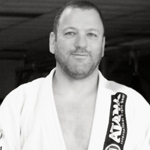Some historians of Jiu-Jitsu say that the origins of “the gentle art” can be traced back to India, where it was practised by Buddhist Monks. Concerned with self-defense, these monks created techniques based upon principles of balance and leverage, and a system of manipulating the body in a manner where one could avoid relying upon strength or weapons. With the expansion of Buddhism, Jiu-Jitsu spread from Southeast Asia to China, finally arriving in Japan where it developed and gained further popularity. In the last days of the 19th century, some Jiu-Jitsu masters emigrated from Japan to other continents, teaching the martial arts as well as taking part in fights and competitions.
Brazilian Jiu-Jitsu is known as more than just a system of fighting. Since its inception in 1914, its parent art of judo was separated from older systems of Japanese jujutsu by an important difference that was passed on to BJJ: it is not solely a martial art: it is also a sport; a method for promoting physical fitness and building character in young people; and, ultimately, a way of life.
Mitsuyo Maeda, a member of the Kodokan, was one of five of judo’s top groundwork experts that judo’s founder Kano Jigoro sent overseas to demonstrate and spread his art to the world. Maeda had trained first in sumo as a teenager, and after the interest generated by stories about the success of judo at contests between judo and jujutsu that were occurring at the time, he changed from sumo to judo, becoming a student of Kano’s Kodokan judo. Maeda left Japan in 1904 and visited a number of countries giving “jiu-do” demonstrations and accepting challenges from savate, boxers, wrestlers fighters and various other martial artists before eventually arriving in Brazil on November 14, 1914.
Gastão Gracie was a business partner of the American Circus in Belem. In 1916, Italian Argentine circus Queirolo Brothers staged shows there and presented Mayeda. In 1917, Carlos Gracie, the eldest son of Gastão Gracie, watched a demonstration by Maeda at the De Paz Theatere and decided to learn judo. Maeda accepted Carlos as a student and Carlos learned for a few years, eventually passing his knowledge on to his brothers.
Carlos Gracie was interested in the practical application of what he had learned in the “anything goes” environment of the street and refined Maeda’s techniques through numerous challenge matches. Carlos even took out an add in the local paper challenging all comers to fight regardless of their size or physical advantages. At a mere 135 pounds Carlos was able to utilize his technique to overcome all opponents and was never defeated.
The refinement of technique through actual competition and the willingness to fight any challenger have become part of the Gracie family tradition. Carlos taught his Jiu-Jitsu to his brothers Oswaldo, Gastão, Jorge, Helio and to his older sons. In turn they would go on to teach their sons, nephews, brothers, cousins and friends. Carlos himself had 21 children, creating a fighting dynasty in only a generation.
Today the Gracie Fighter Team founded by Cesar Gracie continues the tradition of Jiu-Jitsu founded by Carlos by regularly having students compete at the highest levels of Mixed Martial Arts, submission grappling, and sport Jiu-Jitsu.




